|
|
ARTHROPODS:
Insects»
Spiders»
Centipedes»
Millipedes»
Sowbugs»
Harvestmen»
Mites
& Ticks»
Scorpions»
Identification
Tips»
About
the Critter Files»
Links» |
|
|
|
 |
LONG-JAWED
ORB WEAVERS & ORCHARD SPIDERS
Critter
Files/Spiders/Long-Jawed Orb Weavers
& Orchard Spiders
By Blake Newton & Susan Romero
University of Kentucky Department of Entomology |
| |
|
| The spider
family Tetragnathidae includes 2 types of spiders that are closely
related but look very different: the common Long-Jawed Orb
Weavers, and the Orchard Spiders. |
|
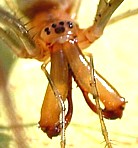 Fangs
of long-jawed orb-weaver
Fangs
of long-jawed orb-weaver
(B. Newton, 2003) |
Long-jawed
Orb Weavers are named because of their large chelicerae
(fangs), which are, in some species, longer than the spider's cephalothorax.
Orchard Spiders
have bodies that are not as long and
skinny as commonly encountered long-jawed orb-weavers. In fact, orchard
spiders look very similar to "true" orb-weaver
spiders (family Araneidae). |
| Like true orb-weavers,
long-jawed orb-weavers and orchard spiders build webs that resemble
a circular grid. However, the webs of spiders in this family
usually do not have as many radii, or "spokes," as those
of true orb weavers. As with all spiders, long-jawed orb weavers
have 8 legs, 2 body parts, and no antennae. All Tetragnathid spiders have 8 eyes. |
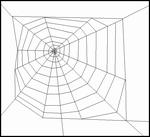 Typical Orb Web
Typical Orb Web |
|
| SIZE:
Body length up to about 1" |
| |
| LIFE
CYCLE |
|
Simple
metamorphosis: like all spiders, young long-jawed orb-weaver spiders
hatch from eggs and look like tiny adults. They shed their
skin as they grow. Most spiders in this family live for less
than one year. They mate and lay eggs at the end of the summer.
The young spiders hatch during the following spring.
|
| |
| Shown below
is the shed-cuticle (called "exuvia") of a long-jawed orb
weaver hanging from a grass blade. Like all insects and spiders,
young long-jawed orb weavers must shed their cuticle as they grow,
a process called "molting." Most insects and spiders
do not grow or molt once they become fully-grown adults, but some
primitive spiders (like tarantulas) continue to grow and shed their
their skins as they age. |
| |
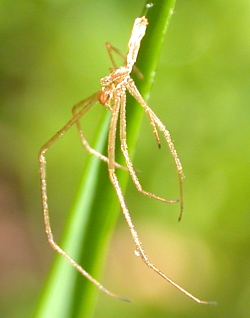 Shed-cuticle
of a Long-Jawed Orb Weaver (B. Newton, 2005)
Shed-cuticle
of a Long-Jawed Orb Weaver (B. Newton, 2005) |
| |
| ECOLOGY |
|
Long-jawed orb weavers
and orchard spiders are very similar to regular orb-weavers. They
build their webs in strategic locations to catch flies, moths, and
other insects. Birds and other small animals often eat these
kinds of spiders.
|
| |
| PEST
STATUS |
|
Long-jawed
orb weaver are not considered pests, and their bites are rare and
are not dangerous except to allergic individuals. |
| |
| COMMON
KENTUCKY LONG-JAWED ORB WEAVERS & ORCHARD SPIDERS |
|
|
COMMON
LONG-JAWED ORB WEAVERS
GENUS: Tetragnatha
We have few species of
Common Long-Jawed Orb Weavers in Kentucky, but
some are very plentiful and easy to find. The most commonly
encountered ones, like the two pictured below, are in the genus
Tetragnatha. They are long (2" leg span) and
skinny. Most are tan with white and yellow markings and are
common in low-growing vegetation and in row crops. Some have
extremely large fangs. Large species like these are
commonly found in sycamore branches that overhang streams and lakes. |
| |
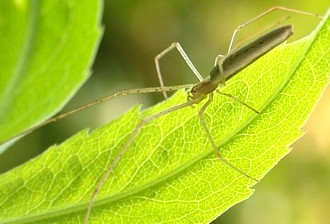 Long-Jawed
Orb Weaver, Tetragnatha genus (B. Newton, 2004)
Long-Jawed
Orb Weaver, Tetragnatha genus (B. Newton, 2004) |
| |
|
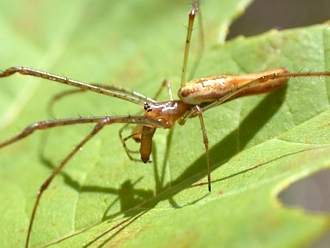 Long-Jawed
Orb Weaver, Tetragnatha genus (B. Newton, 2004)
Long-Jawed
Orb Weaver, Tetragnatha genus (B. Newton, 2004) |
|
|
|
GLENOGNATHA FOXI
GENUS & SPECIES:Glenognata foxi
This long-jawed orb-weaver is quite different from the others shown on this page. Glenognatha foxi is a very small (about 2 mm long) and round spider. However, like other long-jawed orb-weavers, the males have long, curving chelicerae, so they are easy to identify as tetragnathids. Glenognatha builds small webs (4–5 cm in diameter) very close to the ground in lawns and crop fields. Males can often be seen running along on bare soil or leaf litter, and can be recognized by their large, dark, balloon-like palps (see picture below). Both males and females are easily recognized by their distinctive color pattern.
|
| |
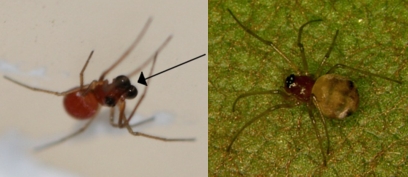 Glenognatha foxi male (left, K. Welch, 2009) and female (right, S. Romero, 2009).
Glenognatha foxi male (left, K. Welch, 2009) and female (right, S. Romero, 2009).
The arrow points to one of the male’s ballon-like palps |
|
|
|
ORCHARD
SPIDERS
GENUS: Leucauge
We have a few species
of Orchard Spiders in Kentucky. They are
in the long-jawed orb-weaver family too, but they more closely resemble
true orb-weaver spiders (family
Araneidae) than they do other members of the long-jawed orb-weaver
family. Orchard spiders often have bright green, white, and
yellow markings. The Leucauge species shown below
was photographed in the Laurel River Lake area in Kentucky. It
is also very common in the Bluegrass region.
|
| |
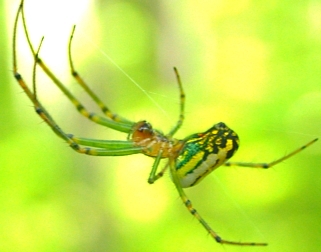 Orchard
spider, Leucauge genus (B. Newton, 2002)
Orchard
spider, Leucauge genus (B. Newton, 2002) |
|
| |
| COLLECTING
& PHOTOGRAPHY |
|
Long-jawed orb-weavers
and orchard spiders are very common in yards, forests, and in crops
like corn and soybean. Look for their webs a few feet off
of the ground. Large (1" long) species of Tetragnatha
are very common in tree branches that overhang lakes and streams.
Often, a long-jawed orb weaver will remain still in its web
so that you can take a good picture. If you are interested
in collecting one of these spiders, remember that they can bite
and should never be handled, although they aren't typically dangerous.
All spiders should be preserved in alcohol. |
| |
| LONG-JAWED
ORB-WEAVER FACTS |
|
Long-jawed orb weavers
(Tetragnathidae) and true orb-weavers (Araneidae) are the only common
kinds of spiders that make orb webs. The webs of most other kinds
of spiders appear disorganized compared to orb webs.
UNC Willmington's "Island Ecology" website maintains an excellent information page about orchard spiders.
Although most of the
long-jawed orb-weavers in Kentucky look like one of the two kinds
pictured above, species in other countries can look very different.
Take a look at these pictures of European long-jawed orb-weavers
by Ed Nieuwenhuys: www.xs4all.nl/~ednieuw/Spiders/Tetragnatidae/Tetragnathidae.htm
|
| |
| MYTHS
- LEGENDS - FOLKLORE |
|
Do you know any myths,
legends, or folklore about long-jawed orb-weaver spiders? If
so, let us know.
|
Original document: 25 May 2004
Last updated: 1 Feb 2010
Photos courtesy R.
Bessin, B. Newton, K. Welch, and S. Romero, University of Kentucky
The Kentucky Critter Files are maintained
by Blake Newton, Department of Entomology, University of Kentucky.
Contact: blaken@uky.edu |
|

